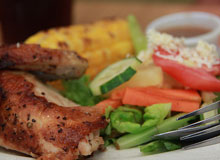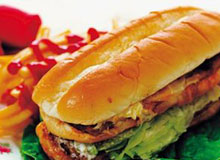Ensuring food safety
 Food safety refers to the safety measures and standards that are to be followed in a particular place. It is a scientific discipline that describes handling, preparation and storage of food in proper ways so that any kind of food borne illness can be prevented. This entire process is a long drawn one. It includes a lot of routines that should be stringently followed in order to avoid potentially severe health hazards. It is thus an extremely integral part of health and safety measures. Food is capable of transmitting diseases from one person to another. It may also serve as a medium for the growth of several bacteria that are capable of causing food poisoning. Sometimes these cases of food poisoning can be extremely fatal in nature. Thus extreme caution should be exercised. There is a lot of debate on the safety factor of genetically modified food. This is due to the fact that the impacts of all genetically modified food on humans have not been assessed completely. Another cause of concern is the genetic pollution of the environment. This has potential to destroy the natural biological diversity causing unimaginable amounts of hazards. Developed countries have strict standards of food safety and preparation. However, lesser developed nations do not have such high grade measures. This is mainly due to the lack of adequate safe water which happens to be the most vital and critical item in terms of food manufacturing.
Food safety refers to the safety measures and standards that are to be followed in a particular place. It is a scientific discipline that describes handling, preparation and storage of food in proper ways so that any kind of food borne illness can be prevented. This entire process is a long drawn one. It includes a lot of routines that should be stringently followed in order to avoid potentially severe health hazards. It is thus an extremely integral part of health and safety measures. Food is capable of transmitting diseases from one person to another. It may also serve as a medium for the growth of several bacteria that are capable of causing food poisoning. Sometimes these cases of food poisoning can be extremely fatal in nature. Thus extreme caution should be exercised. There is a lot of debate on the safety factor of genetically modified food. This is due to the fact that the impacts of all genetically modified food on humans have not been assessed completely. Another cause of concern is the genetic pollution of the environment. This has potential to destroy the natural biological diversity causing unimaginable amounts of hazards. Developed countries have strict standards of food safety and preparation. However, lesser developed nations do not have such high grade measures. This is mainly due to the lack of adequate safe water which happens to be the most vital and critical item in terms of food manufacturing.
Various nations implement different sorts of measures in order to ensure safety of food items. The parliament of the European Union makes legislations in the forms of directives which are compulsory for member nations to follow. These have to be incorporated into the national legislation of each individual nation. The parliament of the European Union is informed on food safety matters by the European food safety authority. Individual nations may exercise certain individual authority over the legislatures provided that they do not interfere or cause any hindrance in the trade going on with other countries. They may also differ in internal structures on matters regarding food safety.
The food agency of the United Kingdom is responsible for policies regarding food safety. The enforcement of these legislatures however, is carried out by “food authorities” which are local bodies. They act in matters of food import and export. The agency is supposed to provide guidelines to food businesses as well as all concerned enforcement bodies. It also carries out publicity campaigns to make people aware of food safety measures. The main control of food is governed entirely by criminal law in the form of food safety act 1990. There are also subordinate regulations which implement European Union directives and regulations concerning hygiene, control, labelling and authenticity. Regulatory control of food is based on sampling provided by public analysts. This includes both chemical as well as microbiological analysis.
We shall now discuss some important terms relating to food safety.
Food quality: This refers to the qualities or attributes that are acceptable to customers. This includes shape, texture colour, gloss, sixe, consistency and flavour.
Adulterated food: Usually impure or unsafe food is termed as adulterated food. It has technical definitions as well in some laws.
Danger zone: This is the temperature range within which food borne bacteria can grow and survive. Usually the range is considered to be forty one degree Fahrenheit to one hundred and thirty five degree Fahrenheit. Potentially dangerous food should never be stored in the danger zone. Any food item that has been in the danger zone for more than four hours should immediately be discarded.
Food contact materials: All materials that can be in contact with food items are termed ad food contact materials. For e.g. glass is a food contact material with respect to soft drinks. Food contact materials can be made from a number of sources. These include plastics, rubber, metal, glass, paper, etc.
Food labelling regulations: This again is a very important and broad section. Thus several topics need to be discussed under this title. We shall speak about the labelling standards that are followed in the United Kingdom.
Name: The name of the product must necessarily inform the customers about its nature. Names should not be ambiguous. It is also mandatory to attach a product description to the item. However, certain generic names must be used for their conventional application. For e.g. coffee, muesli, corn flakes, prawns, chicken, etc.
Ingredients: all ingredients used must be listed under the title of “ingredients”. These should be listed in descending order of their composition by weight. Also, preservatives must be identified by the heading of “preservatives”.
Nutritional information: All nutritional claims must be established with adequate nutritional information supplied by the manufacturer. If somebody claims that his product is “low in sodium” then the claim must be supported by listing all the nutritional information in a tabular manner. As a rule it is expected that manufacturers list down all nutritional information as consumers hold it in very high regard while choosing a particular product.
Medicinal or nutritional claims: These claims are tightly regulated. Some of these are only allowed under certain conditions.
Date tagging: there are two different kinds of date tagging permitted.
The first one is the used by date. This must be followed by the number of days and months within which the product must be consumed. These are usually used on perishable items like fish, meat, milk, etc.
The second one is the best before date. It is an indicator of the time from which the product may start losing its original quality and may degrade. This may be denoted by days, months or years.
Storage conditions: If any particular condition is necessary for storage then it should be separately and clearly mentioned. This is usually applicable for items like medicines.





 High fiber food may perhaps well be the nearly all critical food vogue to comprise move toward prevented of the brand new wave fitness drive with the purpose of nearly all of
High fiber food may perhaps well be the nearly all critical food vogue to comprise move toward prevented of the brand new wave fitness drive with the purpose of nearly all of  Processed food is all on calculate saving, millions of pounds are spent all day on this food, to facilitate manufacturers pump in a daze all day. Such is the methods to facilitate are
Processed food is all on calculate saving, millions of pounds are spent all day on this food, to facilitate manufacturers pump in a daze all day. Such is the methods to facilitate are